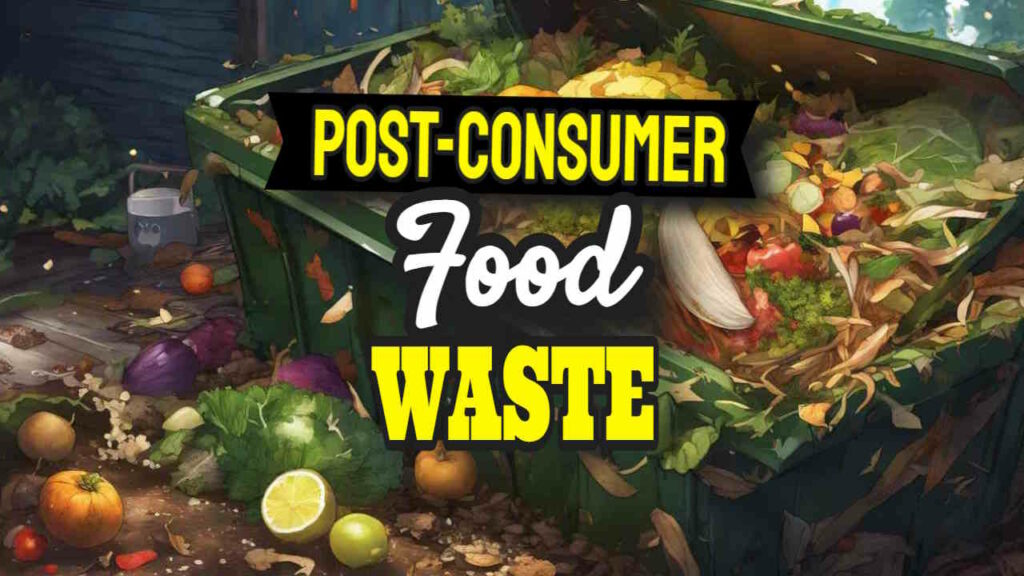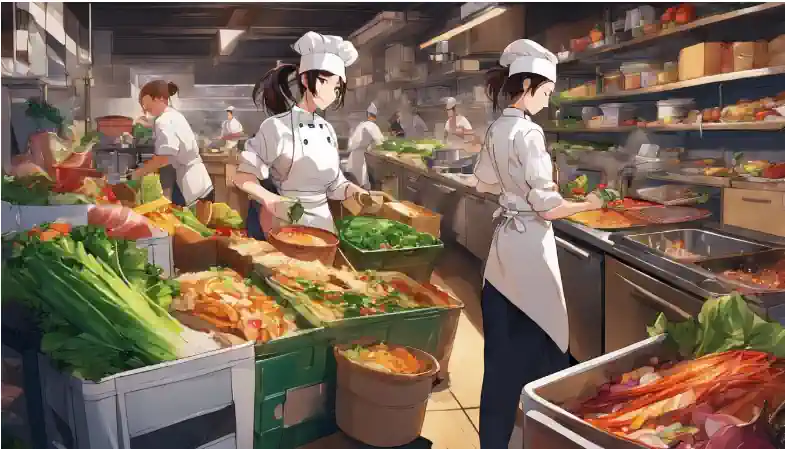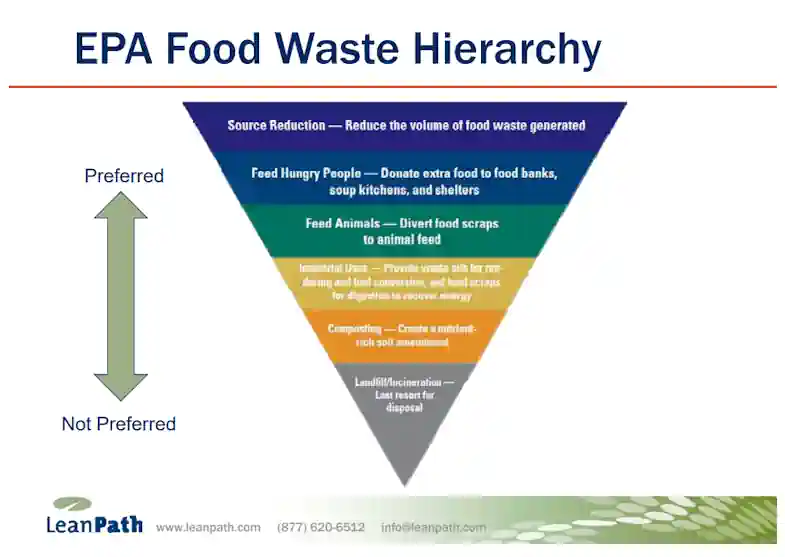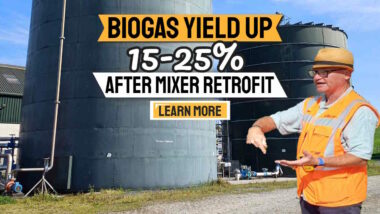Food waste is a big issue all over the world. Every year, loads of food gets thrown away after people eat, and much of this leftover food is called post-consumer food waste. It's important to know that in America alone, people toss out about 60 million tonnes of food every year, which means nearly half their food supply ends up in the bin!
This isn't just happening at home; it's a problem for everyone.
If the climate-changing emissions from global food waste were lumped together and compared with national emissions, food waste greenhouse gas emissions would rank third after China and the US. That's 8 to 10% of all climate changing emissions.
[boomdevs_toc]
Prevention is Better than a Cure
There are many ways to get rid of or recycle this type of waste. Some smart companies are spending more than $3 billion trying to find new ways to fight against throwing away good food. It's called food waste prevention, or finding ways to avoid making the waste in the first place.
But inevitably, even when the work of prevention is done, there will still be a whole lot to handle sustainably. The favourite way to do that is using “cool tech” like turning old leftovers into power through something called anaerobic digestion.
But That's Not the Only Show in Town…
Post-consumer leftovers can also be turned into some great stuff, like biofuel—fuel made from woody plants or old bits of dinner! Some types of post-consumer food waste, generally those that are low in moisture content, can simply be combusted on special burners.
Some of those will be designed to make another cool new product for so many uses, and that's biochar. To you and me, that's much like making charcoal. Charcoal is a form of carbon, and that too has a myriad of sustainable and climate change-mitigating uses.
But most that cannot be avoided will still go to energy production as a feed material for the anaerobic digestion process.

Make No Mistake Food Waste has to be Reduced to Keep Global Temperature Rises Bearable
Things will change when restaurants work harder on not wasting as much and when governments think about making new rules about how we should handle our leftover spaghetti and veggies! And they surely will.
Meanwhile, some places, like the United Kingdom have already done well; they've managed to cut down their food waste by 27% since 2018. But there's still lots more to be done!
By looking at smarter ways to use these leftovers instead of trashing them, we help our planet and maybe even save some money too.
Cool ideas are being turned into reality as we speak with rising growth in food waste-fed anaerobic digestion plants. They turn wasted grub into clean energy—talk about a bright idea!
Let’s dig deeper into how turning last night’s pizza crusts could actually help light up tomorrow.

Key Takeaways
- Every year, the world wastes 1.3 billion tonnes of food, with nearly 60 million tons thrown away in America alone.
- Food waste can be recycled into biofuel through anaerobic digestion, producing biogas for energy and digestate natural fertiliser to help plants grow.
- Training staff in the food service industry to reduce waste and offering smaller portions can significantly cut down on leftovers.
- Laws like organic waste bans and protections for food donations encourage better management of post-consumer food waste.
- Technological solutions aid inventory management in restaurants, preventing over-ordering and reducing excess stock ending up as waste.
- Even once society gets to grips with food waste minimisation there will still be a lot of it to anaerobically digest to make reliable 24/7 renewable energy.

The Scale of Food Waste Worldwide
Food waste is a global issue, with an estimated approximately 1.3 billion tonnes of food being wasted or lost each year. This represents nearly one-third of all food produced for human consumption.

Statistics on food loss and waste
The enormity of the global food waste challenge cannot be overstated, with significant environmental, economic, and social implications. Presented below is a data-driven overview of the statistics on food loss and waste:
| Statistic | Detail | Impact/Remark |
|---|---|---|
| Global Food Loss and Waste | One third of food produced for human consumption | $1 trillion global financial loss annually |
| Reduction Achievement (UK) | 27% reduction in post-farm gate food loss and waste per capita by 2018 | Shows potential for policy and consumer behaviour impact |
| US Food Waste | Nearly 60 million tons thrown away annually | Accounts for almost 40% of the entire food supply |
| Post-Harvest Losses | 30% food waste in less-developed countries | Indicates need for improved storage and transportation |
| Energy Usage in Food System | 38% of total energy used by wasted food | Highlights the environmental impact of inefficiency |
| Consumer Waste Crisis (UK) | In the UK consumers cause 70% of all wasted food and pre-consumer food wastage is therefore only 30% of the total wasted. | Emphasises the role of the consumer in waste reduction |
| International Awareness | International day of awareness of food loss and waste | Highlights the global imperative to address food loss and waste |
These statistics underscore the urgency with which environmental researchers, waste management professionals, and government officials must approach the issue. They point towards a need for innovative methods to mitigate post-consumer food waste.

Characteristics of Post-Consumer Food Waste
Post-consumer food waste comprises a wide range of biomass, including fruit and vegetable scraps, meat and dairy products, as well as leftovers from meals. To learn more about how this waste can be transformed into valuable opportunities, continue reading.
Types of food waste biomass
Food waste biomass comes from our leftover meals and kitchen scraps. This organic waste is rich in calories (energy!) and can be turned into something useful. Here's a look at the various types:
Fruits and Vegetables:
- These are often thrown out from homes and restaurants.
- They have a high water content, making them good for compost.
Bread and Baked Goods:
- Unsold items from bakeries add to this category.
- Their starchiness helps in the anaerobic digestion process.
Dairy Products:
- Spoiled milk and cheese form part of this group.
- They have fats that can be used in biogas production.
Meat and Fish Scraps:
- Leftover meat adds to food waste, especially in fine dining restaurants.
- It decomposes differently because it has proteins.
Coffee Grounds and Tea Leaves:
- These come mainly from cafes and homes.
- Rich in nitrogen, they're great for composting.
Cooked Foods:
- Uneaten portions from meals fall into this class.
- They vary but can still contribute to energy creation through biogas.
Methods of Food Waste Disposal and Recycling
There are various methods for disposing of and recycling food waste, including composting, anaerobic digestion, and animal feed production. These methods help reduce the environmental impact of food waste while also creating opportunities for sustainable resource management.

Disposal options
- Landfills: The most common method where food waste ends up in dumps. However, this causes methane (CH4), a harmful greenhouse gas.
- Incineration: This burns the waste and reduces its volume, but it's not the best for the air we breathe.
- Composting: A natural way to break down food scraps into rich soil that can help plants grow.
- Anaerobic digestion: This process uses microbes without oxygen to turn food waste into biogas, which can be used as energy, and digestate, a nutrient-rich material for soil.
- Animal feed: Some wasted foods that are still safe to eat can be given to animals like pigs and chickens, reducing the need for other feed.
- Industrial composting: Large-scale composting facilities can handle bigger amounts of food waste than home compost bins can.
- Digestion by worms (vermicomposting): Worms eat through the waste, creating high-quality compost for gardens and farms.
- Donation to food rescue organisations: They take safe and unused foods from restaurants and markets to give to those who need it.
Recycling methods
Food waste doesn't have to end up in landfills where it causes harm. There are smart ways to recycle leftovers and turn them into something good for our planet. One method is feeding animals with food scraps that are safe for them.
This reduces the need for new resources to produce animal feed.
Another powerful way to recycle food waste is through anaerobic digestion. This process uses microbes to break down organic matter without oxygen, creating biogas that can be used as energy, and digestate, a rich substance that helps plants grow well in gardens and farms.
These methods help us make the most of every bit of food we produce. Now let's explore how leftover foods can open doors to new opportunities while helping our environment stay clean and healthy.
Transforming Leftovers into Opportunities
Utilising post-consumer food waste in biofuel production and reducing food waste in foodservice are pioneering methods to turn leftovers into opportunities. This section will also explore the legal implications and policy proposals related to transforming food waste into valuable resources.
Utilising post-consumer food waste in biofuel production
Turning food waste into biofuel is a smart way to tackle leftovers. Instead of throwing out uneaten meals, we can use science to make something useful. Experts are finding the best ways to do this with things like anaerobic digestion.
This process takes your leftover food and turns it into biogas and “digestate.” The biogas can be used for energy, which means less reliance on fossil fuels that harm our planet.
There's a group at Worcester Polytechnic Institute working hard on this. They're figuring out how to get biofuel from wasted food better than before. Places like Europe are also trying to show how these leftovers could become valuable resources for making fuel.
It's exciting because using methane from food waste might just be one of the answers we need for cleaner energy in the future.

Reducing food waste in food service
Foodservice industries face a big challenge with food waste. Innovative strategies can turn this problem into a chance for positive change.
- Educate staff on waste reduction: Training kitchen and service employees on how to reduce waste can make a huge difference. Teach them ways to handle, store, and cook food that prevents throwing things away.
- Offer smaller portion sizes: Many customers leave food on their plates because the servings are too large. By providing smaller portions or varied size options, restaurants can cut down the amount of food wasted.
- Improve inventory management: Keeping track of what you have helps prevent over-ordering. Use technology to monitor stock levels and ensure you use ingredients before they spoil.
- Engage in menu planning: Design menus that use similar ingredients across different dishes. This way, chefs can use all parts of an ingredient, reducing leftovers from prep work.
- Encourage customer doggy bags: Make it easy for diners to take leftovers home. Provide containers and promote this as a way to enjoy their meal again later.
- Donate surplus food: Partner with local charities or food banks to give away unused but safe-to-eat items. This approach supports the community while cutting down waste.
- Monitor plate waste: Keep an eye on what comes back uneaten on plates. Analyse this data to see which items often get left behind and consider adjusting those menu offerings.
- Invest in a composting programme: Set up systems where any unavoidable food scraps go into compost rather than the rubbish bin. This turns kitchen waste into useful material for growing more food.
Legal implications and policy proposals
Moving from reducing waste in the foodservice industry, laws and policies play a big role in shaping how leftovers are handled. Organic waste bans can push people to change how they treat left-over food.
In the U.S., efforts like giving protection to those who give away food and organisations that collect it show a move towards better handling of post-consumer materials.
A clear plan is needed to cut down U.S. food wastage by 20%. Such a roadmap will lay out where we're falling short and ways to fix problems in the food supply chain. It's about safety for our future meals and looking after the earth too.
These changes call for everyone involved, from farmers to folks at home, to work together for less waste and more sustainability in our lives.

Conclusion
In conclusion, the strategies discussed can effectively transform post-consumer food waste into valuable resources. By upcycling waste and promoting leftover consumption, we can significantly reduce food waste and its environmental impact.
Are you ready to join the fight against food waste? The practical and efficient methods outlined here provide actionable steps for individuals, businesses, and policymakers to make a real difference.
Embracing these approaches holds the potential to bring about meaningful improvements in sustainable development and food security. Let's work together towards a future where post-consumer food waste becomes an opportunity for positive change!
Post-Consumer Food Waste FAQs
1. What is post-consumer food waste?
Post-consumer food waste is all the food that gets thrown away after people have eaten, like leftovers from meals at home or in restaurants.
2. How can we use leftovers to help the environment?
We can turn leftovers into energy sources like biogas if people:
- put their waste food into caddies (special food waste boxes)
- the local council collects it (known as Source Segregated Organic (SSO) waste, and
- this biowaste goes through a process called anaerobic decomposition, which also helps cut down on water pollution and saves energy.
3. Why should we care about reducing food waste?
Cutting down on food waste helps save water, reduces our carbon footprint, and makes sure more people have enough to eat by improving nutritional security.
4. Do experts study how much food we waste?
Yes! They do studies using things like surveys and statistical tools such as regression analysis to understand why we waste food and how it can be changed.
5. Can turning wasted food into something useful contribute to sustainable development?
Definitely! Sustainable production of new things from wasted food supports the three pillars of sustainability: being good for people, profit, and the planet.
6. Are there plans to make lessening leftover wastes part of bigger goals?
The circular economy action plan aims at keeping resources in use for as long as possible, including finding ways for leftover foods not going to waste but instead becoming valuable again.







